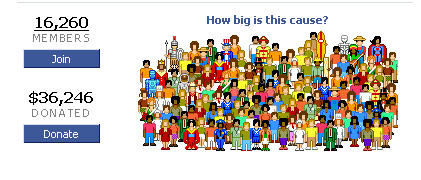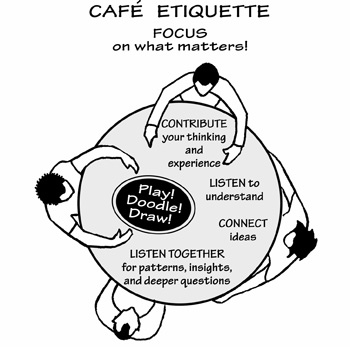
image by altemark
I once worked for a non-profit organization that created a particularly controversial education curriculum for the public school system. After launching the curriculum, the local newspaper published an op-ed piece criticizing it, and negative press soon followed. The organization is local to its city, offering varied projects and services, and funded partially by public funds. All of its good work was lost, temporarily, in the maelstrom following the op-ed piece. This was in the days before social media and Web 2.0. What could my organization do? They tried to get their own op-ed piece published, sent out a press release, spoke at the local city council, sent letters to their members and donors, and organized a neighborhood rally. Did it mediate public opinion? A bit. The biggest problem was that of reach, not message. Secondly was the lack of opportunities to engage directly with its critics.
If this organization were to encounter the same problem today, they could achieve much greater reach and impact using social media applications.
Your organization can’t afford NOT to be on all social media sites relevant to your stakeholders.
Your reputation depends on it.
Let’s look at two companies that faced reputation problems, and what non-profits can learn from them: Network Solutions and Motrin. Jason Falls, at Social Media Explorer, wrote a comprehensive case study about Network Solutions’ reputation problem and analyzed their brand invigoration strategy.
In his case study, Falls explains that “Network Solutions reserved domains that are searched for over a four-day period if they aren’t purchased right away, preventing you from registering them elsewhere unless you call customer service to have them released.” (They have since changed this policy.) Because of this policy, they increasingly encountered soured customers, negative online conversations, and a brand reputation problem. What did they do? They hired a communications firm to monitor and engage in conversations on-line, address issues directly on their blog, and they provided valuable information to their customers through their blog. They fully engaged, directly answered issues, and listened to their stakeholders, using all the available social media tools. Through this invigoration strategy, they directly addressed reputation issues, potentially creating more advocates.
The second case is more recent and public: The Motrin Moms. For those of you unfamiliar with this campaign, Motrin launched a viral video ad in November 2008 offering mothers with back problems from wearing baby carriers relief through Motrin. However, many mothers (myself included) were offended by the implications of the ad: we may not enjoy carrying our children and/or may not want to be labeled as “that kind of mom.” (You can watch the ad here.) The backlash began immediately on Twitter and YouTube. The social web waited while Johnson and Johnson (Motrin’s parent company) did…nothing…for a few days. Eventually, the subsidiary company that markets Motrin emailed apologies to bloggers, and the VP of marketing at Johnson and Johnson apologized to consumers on Motrin’s home page. Critics (myself included) agree that Motrin failed to listen to its critics in real time, reacted too slowly to the reputation crisis, and did not satisfactorily engage with its critics on the social web.
There are several interesting case analyses of this case: Jeremiah Owyang looks at the reputation backlash by the numbers, Pistachio offers her insightful in-the-moment analysis of the issue (with later updates), and David Gelles of the Financial Times wrote a longer piece (reprinted here) that highlights the episode within a larger discussion of brand management.
What is the difference between Motrin’s and Network Solutions’ strategy? Did Motrin open up a special portal for its disgruntled consumers? Did Motrin engage in conversations on the web? Not at all. Motrin (and Johnson and Johnson) talked to consumers, not with consumers. Even today, Motrin’s website is primarily information- and sales-based, with a few FAQs. On the other hand, Network Solutions engaged and addressed critics where they posted in the social web, and learned from it: today Network Solutions asks for customer ideas and feedback on its Ideas Are Power portal.
Two different companies, two different situations, two different approaches. Motrin was hit with a brand reputation crisis, and Network Solutions was trying to raise its reputation and decrease negativity towards the brand. We can learn from these two cases, and hopefully react better than Motrin did.
Organizations must be ready to deal with brand reputation crises. In order to do so, you should have all the appropriate social media tools in place to listen, engage with your stakeholders, and broadcast messages if a crisis hits. What tools should you have in place?
1. A Blog: the only media source fully controlled by you. See John Hayden’s post on 22 Ways A Blog Can Rock Your Non-Profit’s Social Media Campaign.
2. Listening Tools: I previously wrote about how to set up a “listening post” to monitor online conversations about you and your organization. For additional reading, try Chris Brogan’s 5 Tools I Use for Listening.
3. Participate in Social Media Spaces: Where are your stakeholders? Engage with them where they are spending time. Is it on Facebook? Twitter? Bebo? HiFive? LinkedIn? Maybe the local community forum or listserv? Set up a few accounts now and begin engaging with your stakeholders so that if your organization’s reputation is ever questioned, you are in the conversation and able to address the concerns quickly. A plus is that your stakeholders will be more likely to trust your response because you have spent the time building up their trust through your engagement efforts.
4. An Interactive Website: not the static website of old, but one that includes opportunities for engagement, clear calls for action, guest posts by stakeholders, and an Idea Portal.
If you have a great example of crisis reputation management through social media, I’d love to know of it. In another post, I’ll address the issue of proactive reputation management.
 :
:  :
:  :
:  :
:  :
:  :
:  :
:  :
:  :
:  :
:  :
: 

























